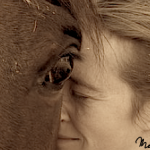Studies, lameness, and other opportunities for critical thinking
| January 23, 2013 | Posted by Melinda under Uncategorized |
Farley is lame.
At first I thought it was a hoof abscess. It was a reasonable conclusion – there is a ton of mud right now, combined with a relatively small pen, and not much riding or turn out, coupled with a sudden onset, acute, toe touching lameness.
However, now I think it’s related to that old wire injury on the left hind. The hoof has gotten soft and the architecture of the split near the heel has changed (doesn’t look like it did before we had all this mud), possibly combined with a current or historical (meaning that it has resolved) abscess that could have easily gained entrance through the compromised hoof at that point.
Within days Farley was moving much better and although today, running around in front of me in the arena she seems sound enough to ride, I’m taking it slow and easy since she still preferentially pivoting on the other hind foot.
Standing in the mud is not a recipe for a sound horse, especially one that isn’t being ridden regularly.
As a nice change I didn’t overreact and run around like a chicken with my head cut off when she presented dead lame that first evening. I evaluated my options and did some critical thinking and made a decision that both me and Farley could live with.
Here was/is my thought process.
1. Most probable “differential diagnosis” for a previously sound horse now “broken leg lame” with no actual sign of broken leg? Abscess.
2. Abscesses are not an emergency and general resolve.
3. How to treat an abscess? Get advice from horsey friends (the 2 legged kind), horse.com (my favorite “laymen’s” site for reliable information), and from the literature.
4. Most friends recommended the conventional wisdom of soaking etc. Horse.com had some older articles that referenced soaking, and newer ones that suggested that soaking wasn’t part of the necessary treatment – this practice was mostly one of those things that probably didn’t hurt, but probably doesn’t substantially help or resolve the issue either. Another friend (endurance background) messaged me to say that last time one her horses had an abcess, the vet’s recommendation was in the “non-soaking” camp and the managed it through pain meds, time off etc.
5. Fact: I do not have the time or energy in my life right now to spend time doing treatments that just make me feel good. I saw enough evidence that soaking may not help to investigate it further.
6. A quick dive into the literature told me that there is not enough evidence that soaking Farley’s hoof was going to be helpful – thus I chose to go the route of bute (Edit: I’m being told that Bute may not be the best choice in an abscess situation – I used 1g once so I’m probably ok. One more example why you should be careful perscription drugs on hand!), rest, turnout/footing management, and a close eye on whether the issue was resolving.
7. Not soaking also fits nicely into my “belief” framework that minimal intervention for hooves is best, which includes soaking and/or putting substances on the hoof. There’s no sign of thrush or anything else abnormal in Farley’s hoof beyond the obvious immediate problem, so nothing is too out of whack –> and I don’t want to disturb that delicate balance. Since I do tend to be drawn to the minimalist approach, this could also be an inherent form of “bias” when I read studies.
8. However, I did pick up an awesome soaking tip from a friend that sounds very doable for me if I ever do need to soak a horse hoof – baby diaper with epsom salts in it, put on hoof with one small opening on top, fill with water and then seal it on.
People throw around the word “studies” a lot –> especially in politics. I can’t count the number of times I heard the phrase “studies show….” in speeches in the last presidential election. Not all studies are valid inherently, not all studies are relevant to the topic people apply them to, and it’s wise to remember that PEOPLE design and write the studies, and studies are not infalliable or always entirely correct. Learning how to read and critically evaluate studies is very important – and once you have a few tricks up your sleeve, you won’t be entirely dependent on your friends and random websites – you will have yet another tool that can help you make decisions.
I’ve run out of time and it’s time to put Farley back in her pen and go to school, so “Mel’s introduction to how to read and interpret literature” will have to wait until next time.










I am on the fence about bute for an abscess and am curious if there is scientific knowledge about the risk of it going “underground”. I too have heard this but feel that the horse moving around can help to push the abscess out. If bute makes the horse less uncomfortable they may move around a little more.
Interesting on the soak-or-not-to-soak debate. Footing management is absolutely gonna be the best solution, IMO. Personally my view on soaking is that since it doesn’t hurt them, why not try it to see if your horse shows any improvement? I like epsom salt baths when my body isn’t feeling good, so maybe pony would like a hoof and lower leg epsom salt bath too, eh? Bute is last resort only for me.
Than I’m glad I only gave 1g of Bute once! Good to know. I think Banamine is more recommended but I didn’t have it on hand. I wanted to make sure that I could evaluate whether she was getting better or worse so wanted to be sparing with the pain meds. For those of you that don’t know what I’m talking about when I refer to the wire injury – it occured before I bought Farley and there’s pics of it on the blog somewhere. At some point I’ll post another pic. Basically it’s a deep groove that goes from the sulcul of the frog, up through the hoof between the frog and heel, into the heel bulb. It looks like a deep crevice or “fold”. Never had problems with it in dry/sand conditions, but the mud is obviously introducing enough moisture or other to have some sort of impact on the hoof. A great example of something that can heal well enough to be functional in 90% of conditions but stress it enough and you will see issues.
I’m no expert, but I have dealt with lots of abscesses over the years. We used to soak them, but now the vet has us wrap them with this “green goo”–and it really works. I’m sure you can find out what this stuff is called from vet student friends, but if not, let me know, and I’ll dig up the right name. Also, my vet doesn’t like bute for abscesses. Apparently it can make the abscess go underground, so to speak, so there are less clinical signs, but its still there and can cause big problems down the road. And I have seen this happen. Hope Farley is better soon!